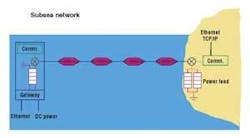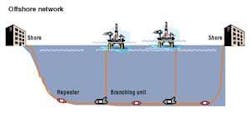Networking options to improve offshore productivity
Marc Fullenbaum, Alcatel Submarine Networks
Communications networks are one of the emerging challenges in exploiting deepwater or remote fields. The upstream sector requires a step change toward real-time decision-making in order to accelerate the time to first oil and improve reservoir extraction.
Most of the technology is available, but to effect reservoir management in real time, the loop must be closed between subsea instrumentation and control systems and distributed communication architecture. What is lacking are long-distance communication solutions based around high reliability, real time, and undersea connectivity.
The solutions could revolve around dry node-to-dry node and dry node-to-wet node architectures. A benefit of the dry-wet solution is the availability of DC power distribution to the wet nodes (about 10 kW per node).
Traditionally, submarine solutions for a core telecommunication backbone incorporate full duplex data transmission, DC power transmission, and packaging of optics and electronics for fault-free subsea use over 25 years. They are based upon undersea repeaters being fed electrically through the line cable. Multiple wavelengths are employed in order to attain high capacity. The main aims are reliability, undersea connectivity, and wide bandwidth.
This technology can be enhanced for the oil and gas environment to allow both offshore (platforms) and subsea connectivity. The respective solutions are the offshore network (dry-dry) and the subsea network (dry-wet).
For inter-platform communications, a multi-wavelength transmission is adopted under which each platform uses two wavelengths, all independent from those of the other platforms. Consequently, the platforms are also independent from one another, so the communication can be maintained even if one installation shuts down entirely or drifts away.
Each platform receives the same signals from the west and east sides via a ring architecture, based on the use of alternate path to shore. Standard-based IP routers and Ethernet switches will allow provision of IP/VLAN connections. This network provides managed bandwidth and dedicated quality of service for all services on the platforms, such as voice, video, data, remote control and monitoring. Such a network can serve over 40 platforms.
The subsea network will typically provide full duplex Ethernet communication and DC power at a control distribution unit through a gateway. This cabled solution is independent and separate from any umbilical solution.
This solution provides open interfaces (400V DC, Ethernet) for easier integration with a stand-alone capability. It also allows status monitoring of the communication unit, DC/DC converters, and the full submarine line.
A 1+1 configuration will achieve 99.99% class availability by running two separate cables in parallel to two gateways. Moreover, branching units can be called on for future expansion to serve other locations.
This network will give the control system vendors a tool to not only run the subsea LAN to effect well control, but also to provide electrical power to instrumentation and control gear.
DC power distribution is much more effective than AC power and will allow supply of ten’s of kW for subsea locations hundreds of kilometers from the shore.
Alcatel is experienced in full turnkey repeatered solutions, having supplied over 200,000 km of cable, 4,000 repeaters and 70 branching units. In 2008, the company is contracted to deliver the Neptune cabled subsea observatory, the world’s first regional scale subsea network equipped with scientific instruments on the seabed.
Neptune will be 800 km long with four undersea nodes and four branching units. The network will be DC-fed, with Ethernet full duplex to/from the nodes.


